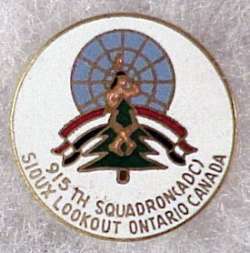NOTICE:Some photos and documents may be marked with varying degrees of classification, up to SECRET. Data so marked is the way it was delivered from official USAF sources, and have been completely declassified. To the best of our knowledge, no currently classified data is stored on this site.The following site information is available: History of Sioux Lookout AS, ON, CNStation Sioux Lookout (site C-16, callsign Sharecrop) was adjacent to Pelican Lake. Although geographically it is only three miles to the town of Sioux Lookout, it more like 13 miles by road, due to all the lakes that separate the two sites. The station is located 43 miles north of the junction of Highway 72 and the Trans-Canada Highway. The highways merge at Dinorwic, Ontario, almost halfway between Winnipeg, Manitoba and Thunder Bay Ontario.In 1951, Sioux Lookout was sited for a joint American/Canadian project. The future home of the radar station was a former Ontario Lands and Forest Fire Tower area. The radar site at Sioux Lookout began construction in 1951 at Pelican Lake and was completed in late 1952. The site was first occupied by the USAF's 915th Aircraft Control & Warning Squadron on 5 December 1952 when the main body arrived. The squadron had formed on 17 March 1952 at Grenier AFB, New Hampshire, and began training for deployment to Canada, at what was to become known as Sioux Lookout Air Station. The unit started limited operations in April 1953 in an early warning role and was declared fully operational on 15 July 1953. The 915th supported the Central Air Defence Force until 1 January 1959 when they became part of the 37th Air Division of the Eastern Defence Force. When the 37th was disbanded in April 1959, they came under the 30th Air Division and then the 23rd NORAD Region at Duluth, Minnesota.The station was very community minded; the personnel and their families did much to improve relationships with the communities of Sioux Lookout and Hudson. In May 1958, the Uren-Dadson Memorial Recreation Centre was dedicated in honor of the memories of Sgt. (Gunner) Edwin Uren, RCAF, and Staff Sergeant Pat Dadson, United States Army Corps. Both were air gunners and age 22 when they were killed in action. (Uren's hometown was Sioux Lookout). On 1 October 1962, the Stars and Stripes were lowered to make way for the Canadian Red Ensign. The RCAF assumed control of the station, renaming it RCAF Station Sioux Lookout. 39 Radar Squadron took over from where the 915th left off. The station was SAGE-capable in 1963. The callsign of the station, in later years, had been "Black Magic". A number of events, some of significant nature, took place at Sioux Lookout in 1967. "The Big Fire of 1967" almost wiped out the radar station that summer. The fire started around noon, the first Saturday of June, on the shores of Patara Lake, located six miles from town. High winds fanned the flames and the fire began to get dangerously close to the station. The station was evacuated in the evening. A number of fire bombers battled the encroaching inferno. During the afternoon, all power was lost after a hydro line was burned down. Power did not return until the next evening. The order came at 1315 hours on Sunday afternoon to abandon the town site. People left in the direction of Dryden by whatever means they could find. Fortunately, the fire was brought under control by Sunday evening. For the military, the damage was one collapsed FPS-26 tower, one scorched radome, a few scorched buildings, the station welcoming sign destroyed, and two mobile homes incinerated at the Ojibway Village Trailer Park. In December 1967, the station was the sight for the 1968 Canadian Biathlon Championship and Cross Country Races. In February 1968, as a result of unification, the station became Canadian Forces Station Sioux Lookout. In 1969, the improbable happened; CFS Sioux Lookout won the coveted Steinhardt Trophy for excellence in air defence. They were the first radar station to win it. In May 1978, as part of the Station's 25th Anniversary Celebration, the Sam Lake Sprockets peddled their way (all 295 miles of it) to Winnipeg during a bike relay. In September 1983, Mayor John Parry honored Sioux Lookout with the granting of Freedom to the Town of Sioux Lookout. In August 1984, the station became part of the Canada East ROCC. The station which had become known as "The tops on the Treeline" was shut down on 31 July 1987. -- The NBC Group - Don Nicks, John Bradley, Chris Charland. |
 |